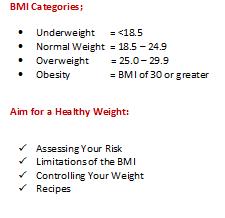These increasing rates raise concern because of their implications for Americans’ health. Being overweight or obese increases the risk of many diseases and health conditions, including the following:
* Hypertension
* Dyslipidemia (for example, high total cholesterol or high levels of triglycerides)
* Type 2 diabetes
* Coronary heart disease
* Stroke
* Gallbladder disease
* Osteoarthritis
* Sleep apnea and respiratory problems
* Some cancers (endometrial, breast, and colon)
Although one of the national health objectives for the year 2010 is to reduce the prevalence of obesity among adults to less than 15%, current data indicate that the situation is worsening rather than improving.
Maintain a Reasonable Body Mass
Body mass index (BMI) is a measure of body weight relative to height. You can use BMI to see whether you are underweight, normal weight, overweight, or obese. Use the body mass index table to find your BMI.
> Find your height in the left-hand column.
> Move across in the same row to the number closest to your weight.
> The number at the top of that column is your BMI. Check the word above your BMI to see whether you are normal weight, overweight, or obese.
Click table below to view it larger image;

“ Fitness quote- People who don't have time to exercise, will have to take out time for bed rest.”







